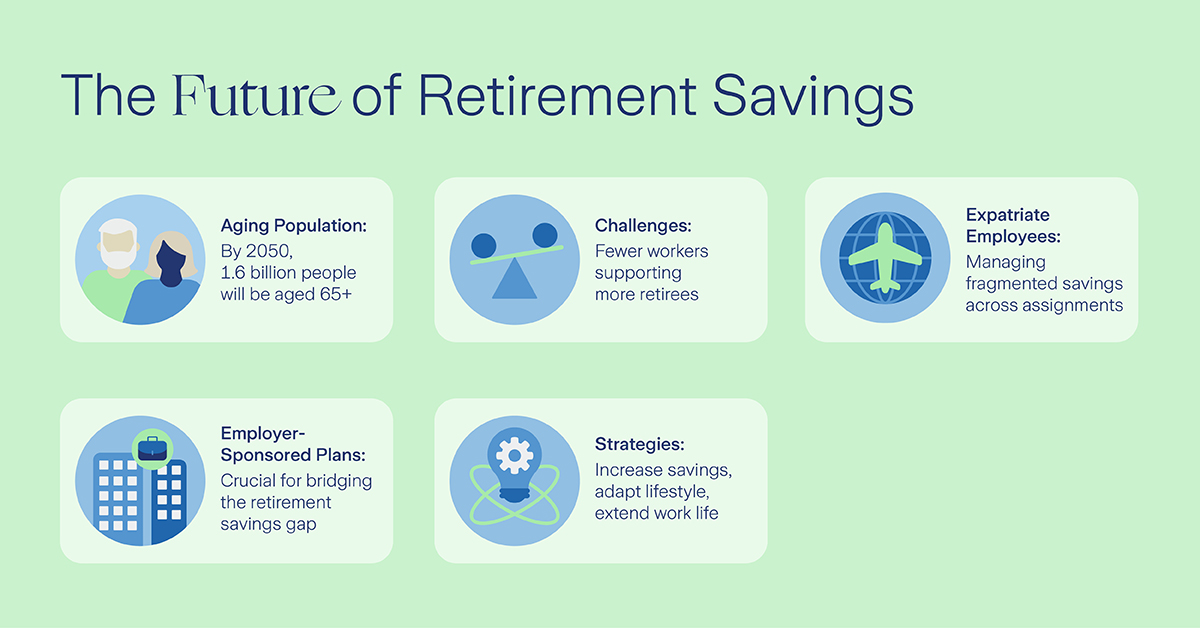Adapting to Change: Evolving International Corporate Savings
ArticleJune 5, 2025
As the landscape of corporate savings solutions evolves, it’s important to stay informed about key trends and initiatives that multinational companies are taking to ensure financial security for their employees.
The shifts in corporate savings solutions are driven by several key factors including the move from defined benefit (DB) to defined contribution (DC) plans, the integration of financial wellbeing programs, the emergence of hybrid plans, as well as the challenges posed by aging populations on retirement savings. Below, we explore the impacts of these drivers and resulting trends in International Corporate Savings solutions.

Global Minimum Benefits Standards
There is a growing trend towards establishing global minimum benefits standards, ensuring a baseline level of retirement savings benefits across multinational organizations. This movement aims to provide a consistent level of financial security for employees regardless of their location, promoting fairness and reducing disparities in retirement outcomes.
Shift to defined contribution plans and long-term savings
There is a continued shift from defined benefit (DB) plans to defined contribution (DC) plans. Employers have been increasingly favouring DC plans due to their cost predictability and reduced financial risk. Additionally, there is a trend among multinational employers to provide long-term savings plans either in lieu of or alongside more traditional pension plans, allowing for greater flexibility in meeting the diverse needs of a global workforce.
Automatic Enrolment
More organizations are implementing automatic enrolment features in their retirement plans to boost participation rates. This strategy has proven effective in increasing employee engagement in retirement savings. However, it may create the expectation that enough is being saved as individuals are in a pension plan with the connotations of past DB plans. It is crucial for employers to communicate clearly that automatic enrolment is just a starting point and encourage employees to review and adjust their contribution levels as needed.
Focus on Financial Wellbeing
Employers are enhancing their retirement savings plans by integrating financial wellbeing programs. These programs aim to improve employees' financial literacy and help them make better retirement planning decisions. By offering resources such as financial education workshops, personalized financial advice, and tools for budgeting and saving, employers can help employees feel more confident in their financial futures.
Increased Employer Contributions
Employers are increasing their contributions to retirement savings plans to attract and retain talent. This includes matching contributions and offering additional incentives for higher savings rates. By providing generous employer contributions, companies can enhance their benefits packages and support employees in building more substantial retirement savings.
Hybrid Plans
There is a rise in the adoption of hybrid plans that combine elements of both DB and DC plans. These plans offer more predictability for employees while managing costs for employers. Hybrid plans can provide a balance between the guaranteed income of DB plans and the flexibility and portability of DC plans, making them an attractive option for many organizations.
End of Service Benefit Funding in the Middle East
In regions like the Middle East, there is a gradual move toward making End of Service Benefit (EOSB) funding compulsory. Traditionally, EOSB has been an unfunded liability for employers, paid out as a lump sum when an employee leaves the company. However, there is a growing recognition of the need to secure these benefits through funded arrangements. This shift aims to ensure that employees receive their due benefits even if the company faces financial difficulties, providing greater financial security and stability for the workforce.
As retirement benefit schemes continue to evolve, it's essential for both employers and employees to stay informed and proactive. By understanding the different approaches and implementing effective strategies, we can work towards a more secure financial future for all.

Source: 2024 Global Benefits Trends Study, Aon

Mark Belcher
International Corporate Distribution Manager at Zurich Integrated Benefits
To learn more about the trends in international corporate savings plans reach out to Mark Belcher at
mark.belcher@uk.zurich.com Visit profile
For broader employee benefits insight follow Zurich Integrated Benefits
